The AMD Trinity Review (A10-4600M): A New Hope
by Jarred Walton on May 15, 2012 12:00 AM ESTAMD Trinity General Performance
Starting as usual with our general performance assessment, we’ve got several Futuremark benchmarks along with Cinebench and x264 HD encoding. The latter two focus specifically on stressing the CPU while PCMarks will cover most areas of system performance (including a large emphasis on storage) and 3DMarks will give us a hint at graphics performance. First up, PCMark 7 and Vantage:
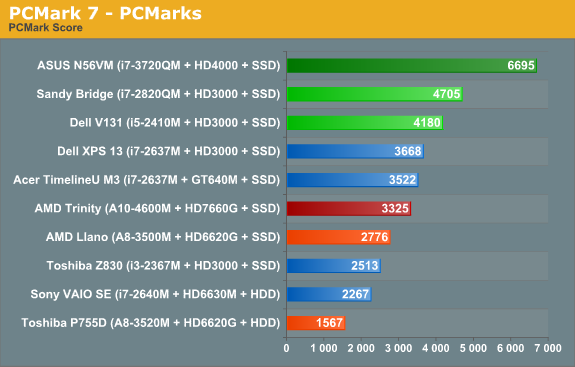
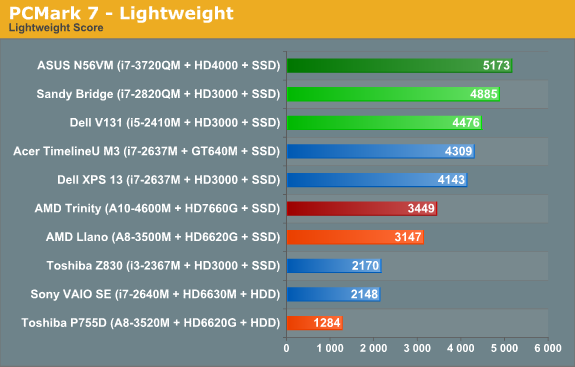
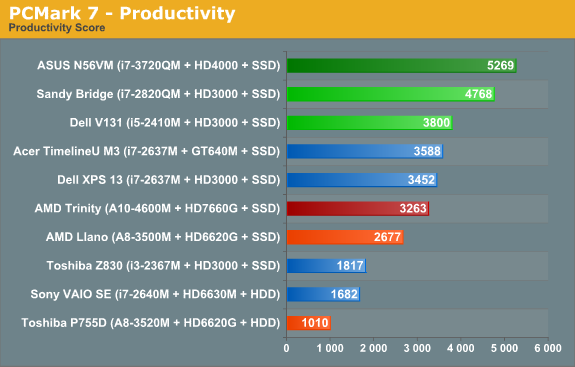

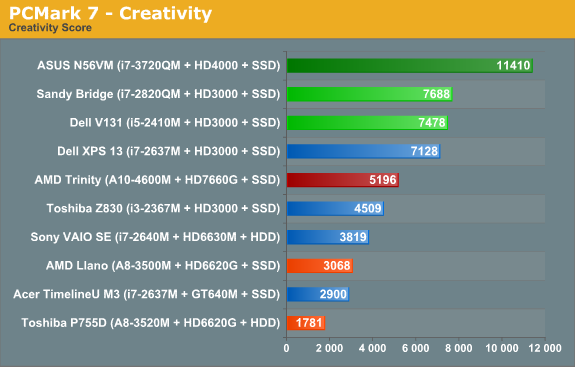
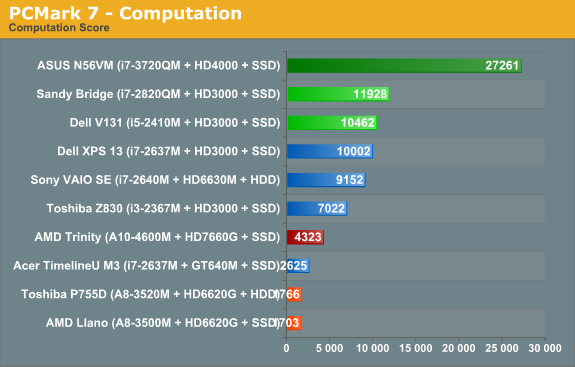
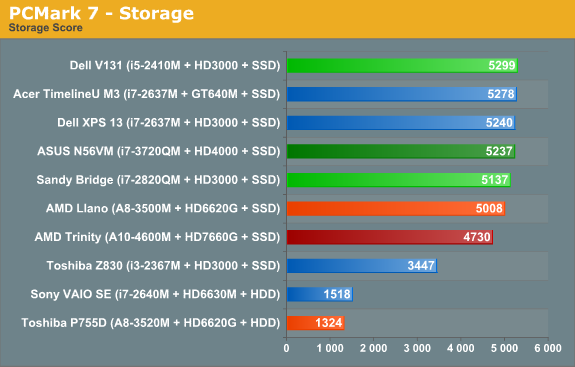
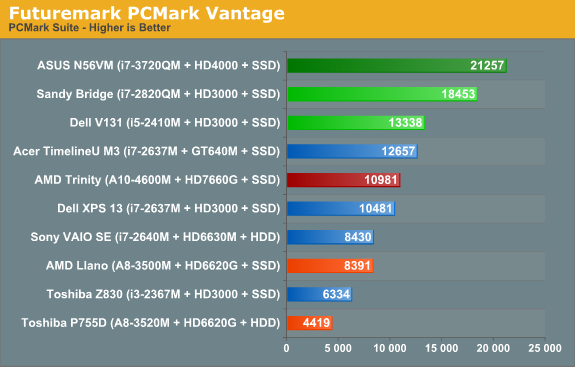
As noted earlier, we ran several other laptops through PCMark 7 and PCMark Vantage testing using the same Intel 520 240GB SSD, plus all the ultrabooks come with SSDs. That removes the SSD as a factor from most of the PCMark comparisons, leaving the rest of the platform to sink or swim on its own. And just how does AMD Trinity do here? Honestly, it’s not too bad, despite positioning within the charts.
Obviously, Intel’s quad-core Ivy Bridge is a beast when it comes to performance, but it’s a 45W beast that costs over $300 just for the CPU. We’ll have to wait for dual-core Ivy Bridge to see exactly how Intel’s latest stacks up against AMD, but if you remember the Llano vs. Sandy Bridge comparisons it looks like we’re in for more of the same. Intel continues to offer superior CPU performance, and even their Sandy Bridge ULV processors can often surpass Llano and Trinity. In the overall PCMark 7 metric, Trinity ends up being 20% faster than a Llano A8-3500M laptop, while Intel’s midrange i5-2410M posts a similar 25% lead on Trinity. Outside of the SSD, we’d expect Trinity and the Vostro V131 to both sell for around $600 as equipped.
A 25% lead for Intel is pretty big, but what you don’t necessarily get from the charts is that for many users, it just doesn’t matter. I know plenty of people using older Core 2 Duo (and even a few Core Duo!) laptops, and for general office tasks and Internet surfing they’re fine. Llano was already faster in general use than Core 2 Duo and Athlon X2 class hardware, and it delivered great battery life. Trinity boosts performance and [spoiler alert!] battery life, so it’s a net win. If you’re looking for a mobile workstation or something to do some hardcore gaming, Trinity won’t cut it—you’d want a quad-core Intel CPU for the former, and something with a discrete GPU for the latter—but for everything else, we’re in the very broad category known as “good enough”.


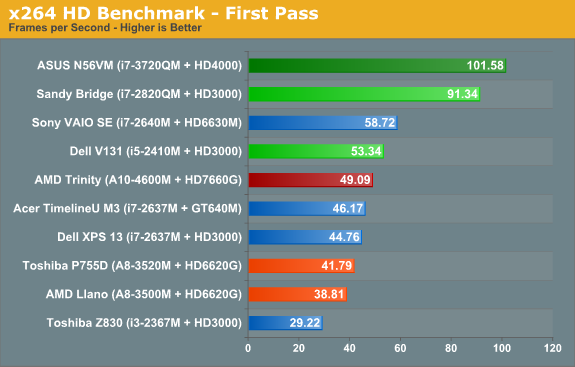
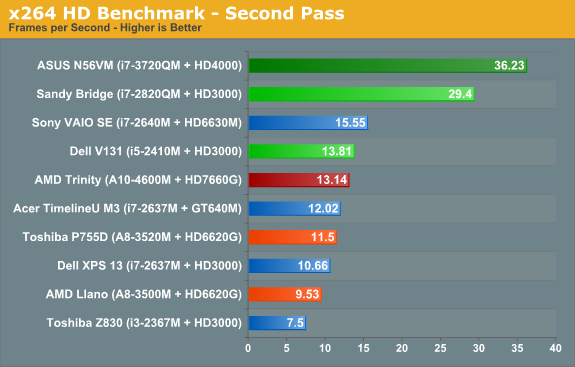
When we start drilling down into other performance metrics, AMD’s CPU performance deficiency becomes pretty obvious. The Cinebench single-threaded score is up 15% from 35W Llano, but in a bit of a surprise the multi-threaded score is basically a wash. Turn to the x264 HD encoding test however and Trinity once again shows a decent 15% improvement over Llano. Against Sandy Bridge and Ivy Bridge, though? AMD’s Trinity doesn’t stand a chance: i5-2410M is 50% faster in single-threaded Cinebench, 27% faster in multi-threaded, and 5-10% faster in x264. It’s a good thing 99.99% of laptop users never actually run applications like Cinebench for “real work”, but if you want to do video encoding a 10% increase can be very noticeable.

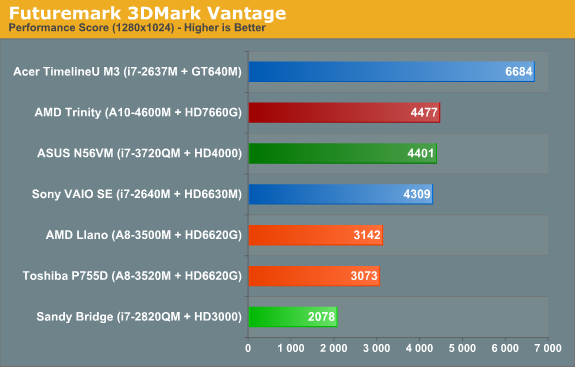
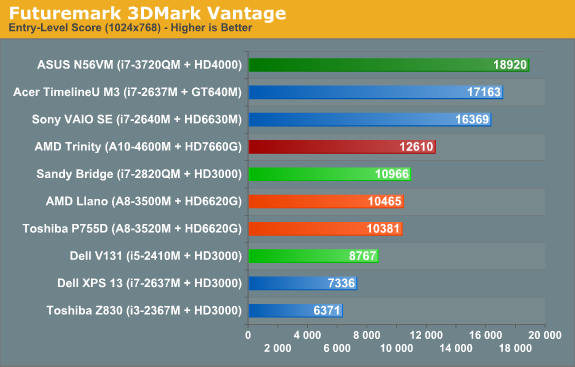
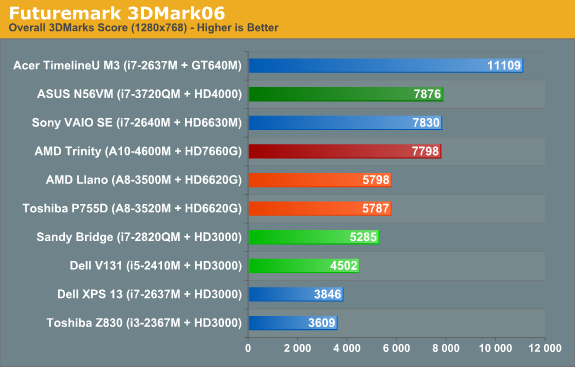
Shift over to graphics oriented benchmarks and the tables turn once again...sort of. Sandy Bridge can’t run 3DMark11, since it only has a DX10 class GPU, but in Vantage Performance and 3DMark06 Trinity is more than twice as fast as HD 3000. Of course, Ivy Bridge’s HD 4000 is the new Intel IGP Sheriff around these parts, and interestingly we see Trinity and i7-3720QM basically tied in these two synthetics. (We’ll just ignore 3DMark Vantage’s Entry benchmark, as it’s so light on graphics quality that we’ve found it doesn’t really stress most GPUs much—even low-end GPUs like HD 3000 score quite well.) We’ll dig into graphics performance more with our gaming benchmarks next.










271 Comments
View All Comments
Beenthere - Tuesday, May 15, 2012 - link
Many students game on laptops and that's a large market segment with many people desiring portability by necessity these days.aliasfox - Tuesday, May 15, 2012 - link
Your average kid going into undergrad who doesn't care enough to spend more than $1k (or more than $700) for a computer will be pleasantly surprised when he/she fires up some random game - and releasing these machines right now is perfect timing to get product on the shelves for college back-to-school season.It's really all about 'good enough' on SC2 or Portal or whatever else people will pick up for a few hours a week. They don't care about 100 fps at insane external monitor resolutions with megapixels worth of textures, but if they can get >20-30 fps at 768p or 900p on whatever they might throw at it, they're happy enough.
I used to be of them.
mikato - Wednesday, May 16, 2012 - link
Me too. I played Quake 3 on an 8MB video card for quite a while on my desktop and everything worked well enough for me to kick butt with the rail gun :) It was great to play for a few minutes or an hour to unwind a bit.Caltek9 - Tuesday, May 15, 2012 - link
jwcalla,I'm actually totally interested in gaming on a lower-end laptop right now, and am trying to decide whether to wait for Trinity or not. I'm going to grad school (undergrad and building gaming towers was many years and 2 children ago), and need a light laptop with good battery that I can play recent games on (Diablo III, Kingdoms of Amalur, Saints Row the Third, Borderlands). The reason the Trinity setup is intriguing to me is because if the GPU works out, I can get (supposedly/hopefully) a very slim laptop that can do this, instead of a heavier one. I'll be going to grad school in Europe, and every pound I can shave off before I travel is a good thing! I've been a console gamer for far too long (since abandoning the PC after undergrad), so I'm used to not having the best looking graphics. As long as it can play a game smoothly, and at decent graphical settings, I'm fine with that.
I get a bit sad when seeing the Trinity CPU numbers, but keep trying to convince myself that it won't matter to me, since I'll mainly be typing papers, and surfing the Internet, and not transcoding anything with gaming on the side. I'm writing this on an Intel-based Mac, so I'm not a fanboy of either AMD.
Bottom Line: I want cheap, light, good battery, and the ability to play recent games at medium settings. Trinity seems to be able to do this better than Ivy Bridge, at least in these early reviews.
SIDE NOTE: Until I see an actual laptop with Trinity in the wild, this is my current choice for a replacement laptop (Sager NP6110/Clevo W110ER): http://www.xoticpc.com/sager-np6110-clevo-w110er-p...
I'm a bit worried about the screen and keyboard sizes for papers, but suppose I could hook them up to externals.
Gigantopithecus - Tuesday, May 15, 2012 - link
PCPer shows the A10-4600M absolutely trouncing the i7-3720QM (http://www.pcper.com/files/review/2012-05-13/gamet...What explains the dramatic discrepancy between their results and Anandtech's?
Gigantopithecus - Tuesday, May 15, 2012 - link
...in Skyrim, and here's a working link: http://www.pcper.com/files/review/2012-05-13/gamet...tipoo - Tuesday, May 15, 2012 - link
Anandtech tested at low details, in your link its medium. The HD4000 has decent pixel fill rate, but pretty bad pixel shader performance. So more details = it falls further behind.JarredWalton - Tuesday, May 15, 2012 - link
Good try, but you're wrong. We test at Medium details, with FXAA disabled and anisotropic filtering set at 4x. We also have the high resolution texture pack installed, though I'm not sure if it's always active at low details. Finally, Skyrim is a massive game. I specifically ran around looking for areas (on my desktop system) where performance was lower so that we could give more of a "this is as bad as it gets" score. That ended up being near Whiterun. Go into dungeons and such and the game runs two or three times as fast as our benchmark section.tipoo - Tuesday, May 15, 2012 - link
My mistake, I read "value" and assumed low settings. So if they were both at medium, why are the winner and loser completely flipped? Your explanation would explain the lower framerate, but not a complete flipping of winner and loser.JarredWalton - Tuesday, May 15, 2012 - link
It could be that Whiterun has lower framerates because of CPU bottlenecks as opposed to GPU bottlenecks. I honestly don't know, and I don't know what areas others are using for testing. I suppose I could always try benchmarking a different section of the game to see what happens.It's also possible that FXAA and anti-aliasing in general is the cause of the discrepancy. I never turn on AA personally until I'm at the point where I've maxed out other settings and I still have room to spare. Jaggies just don't bother me all that much, particularly at native resolution on LCDs, and FXAA is basically a blur filter for the whole screen -- you lose jaggies as well as details.